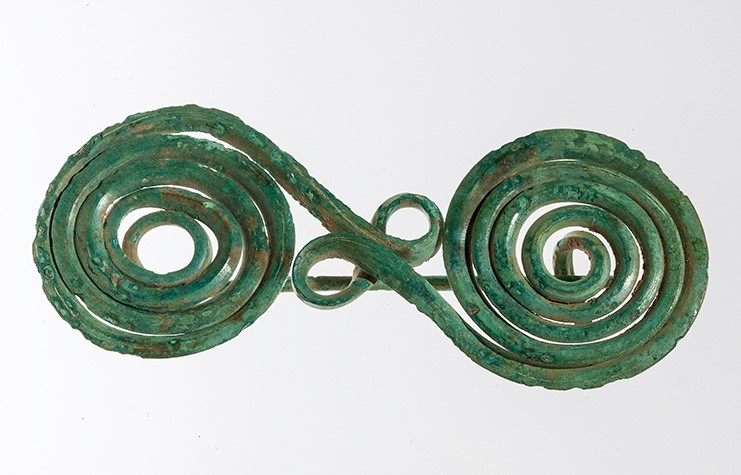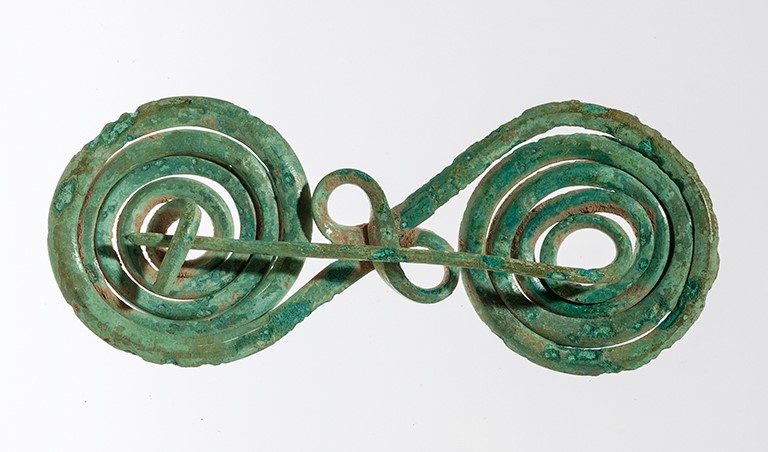Acquisition number: 1980.12
In good condition. The whole is made from a single length of bronze. The strip is quadrilateral in section at the front but rounded for the pin and clip behind. The decorative front part comprises two spirals, their centres leading back to pin and clip, their outer edges joined in a figure-of-eight. The pin runs from the back of the centre of one spiral, and the clip-hook from the back of the other. They show only a little diminution in the diameter of the wire.
The type is known as a spectacle fibula, and it probably dates to the eighth century BC. The style fits well with the Geometric style of contemporary pottery.
Title: Bronze Spiral Brooch - 1980.12
Acquisition number: 1980.12
Author or editor: J.R. Green
Culture or period: Greek Archaic.
Date: 8th century BC.
Material: Metal - Bronze
Object type: Jewellery
Dimensions: 68mm (l) × 27mm (w)
Origin region or location: Greece
Display case or on loan: 1
Keywords: Greek, Archaic
Charles Ede Ltd (London), Antiquities 117 (1980) no. 45 (ill.).
1980.12
Bronze Spiral Brooch
Purchased. Length 6.8cm; width ca 2.7cm.
In good condition. The whole is made from a single length of bronze. The strip is quadrilateral in section at the front but rounded for the pin and clip behind. The decorative front part comprises two spirals, their centres leading back to pin and clip, their outer edges joined in a figure-of-eight. The pin runs from the back of the centre of one spiral, and the clip-hook from the back of the other. They show only a little diminution in the diameter of the wire.
The type is known as a spectacle fibula, and it probably dates to the eighth century BC. The style fits well with the Geometric style of contemporary pottery.
For other examples of spectacle-fibulae (Brillenfibeln), see H. Philipp, Bronzeschmuck aus Olympia (OlForsch XIII, 1981) no. 1070 pl. 65, p. 295ff.; in her n.501, she lists pieces of this type with two spirals from the Peloponnese. See also K. Kilian, Fibeln in Thessalien von der mykenischen bis zur archaischen Zeit (PBF XIV.2, 1972) 142ff. An important earlier study was Chr. Blinkenberg, Fibules grecques et orientales (Lindiaka V, Copenhagen 1926); he discussed brooches of this general kind together with lists of examples from a range of Greek sites at 253-262.
M. Comstock and C. Vermeule, Greek, Etruscan and Roman Bronzes in the Museum of Fine Arts, Boston (Boston 1971) 206 no. 268: is a comparable spectacle-fibula. There are two large spirals made of one wire, with a double twist between them. The pin, of ‘safety-pin’ shape, has the back riveted to the center of each spiral. Its length is 18.6cm. Although it was bought in Naples, they reckon it Greek. Another comparable piece is their 233 no. 335, length 18.3cm. Two large spirals are joined by a double loop, formed of a single wire, round in section. On the back, a ‘safety-pin’ is riveted to the centre of each spiral.
Compare Olympia iv, pl. 21, no. 359.
Important in the scholarship on the type is J. Alexander, “The Spectacle Fibulae of Southern Europe”, American Journal of Archaeology 69, 1965, 7-23, and more recently H. Donder, Katalog der Sammlung antiker Kleinkunst des Archäologischen Instituts der Universität Heidelberg iii.2. Die Fibeln (Mainz 1994) 76-79 with reference to her no. 41, pl. 9. The type seems to appear first in areas to the north, in southern Bavaria and the Tyrol, and there were distribution centres in Austria, Slovenia, northern Croatia and western Hungary. It then spread southwards into Greece and Italy and as such is a remarkable testament to links across these parts of the world in the so-called Dark Ages. In Italy they are found in Picenum, Apulia, Calabria, Campania and Lucania where the idea for their manufacture seems to have come from Greece. When faced with unprovenanced examples, it is not always easy to distinguish South Italian from those made in Greece.
The centres of the spirals on ours are open. Those with iron studs through the centres have been found in southern Italy but not in Greece: see Alexander.
The Heidelberg example, which is from Italy, is much larger than ours, having a length of 22.5cm.
The type is a long-lasting one. In the north it seems to appear in the 12th century and to have lasted until the end of the sixth century in Hallstatt culture. In Greece it is found from the ninth century. In Italy it is found from very soon afterwards but is at its most popular in the seventh and sixth centuries.
Charles Ede Ltd (London), Antiquities 117 (1980) no. 45 (ill.).

